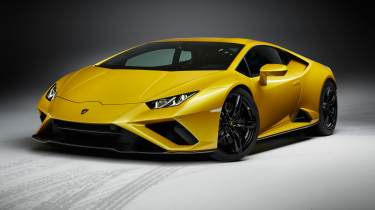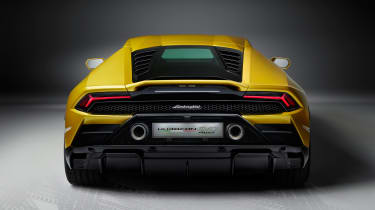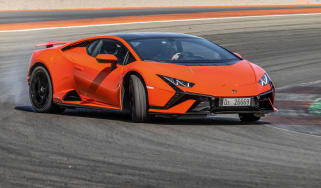New Lamborghini Huracan Evo RWD aims to be the driver's choice
Lamborghini expands the Huracan Evo range with a pared-back Rear-Wheel Drive model focused on driving fun. What's not to like?
Twelve months on from our first drive in Lamborghini’s new Huracan Evo, Sant’Agata has announced a new rear-wheel drive derivative: the Huracan Evo Rear-Wheel Drive (RWD). Powered by a detuned version of the Evo’s 5.2-litre, Audi-built V10, the latest Huracan produces 610hp, 413lb ft of torque and will cost £165,256 when deliveries start later this year.
As with the previous generation Huracan, this new rear-wheel drive Evo model does away with the four-wheel drive system, saving 33kg over the all-wheel drive model’s 1422kg dry weight. Although this weight reduction also results in a traction reduction, hence why the new RWD model requires an additional four-tenths of a second to reach 62mph from a standstill over the all-wheel drive car’s 2.9 seconds and three further agonising tenths to reach 124mph compared to the nine seconds required by the four-wheel drive model. Like its 4WD counterpart, the rear-drive car will top 201mph and is only available with a seven-speed double-clutch transmission.
It’s no quicker but the Huracan Evo RWD is, says Lamborghini, engineered to be more fun, more engaging and more thrilling to drive. Much of these improvements have been achieved via a thorough reprogramming of the car’s electronic driver aids - Performance Traction Control System (P-TCS) in Lamborghini speak.
Therefore, unlike the four-wheel drive Huracan the new RWD model doesn’t have four-wheel steering nor the complex four-wheel torque vectoring, which means this entry model doesn’t come equipped with Lamborghini Dynamic Veicolo Integrata, the trick software developed for the four-wheel drive Huracan Evo that constantly manages power and torque splits between front and rear axles, four-wheel steering and torque vectoring applications.
The traction settings are calibrated to the selected driving mode - Strada, Sport and Corsa - with the system at its most protective in Strada with the shackles gently released as you run through the modes. Sport allows more slip and larger slide angles and Corsa focusses on optimising its cornering speed by smoothing out its intervention by 30 percent over the previous RWD Huracan, improving corner-exit traction by 20 percent and enhancing oversteer by 30 percent. And worry not, because you can also turn the ESC completely off if you so desire.
A chassis consisting of steel springs and hydraulic dampers is standard, with Lamborghini’s ‘MagneRide’ electromagnetic dampers available as an option. 19 inch wheels and a Lamborghini specific Pirelli P Zero tyre is standard (245/35 for the front, 305/35 at the rear), with wheels an inch larger in diameter also available as an option. Carbon-ceramic brakes are also a cost option, replacing the standard 365mm and 356mm front/rear steel discs.
Spotting an all-wheel drive Huracan Evo from a rear-drive example isn’t going to be easy. There’s a new front splitter and vertical fins within larger front air intakes. The rear bumper, finished in high gloss black, incorporates a unique new diffuser.
In a world of turbochargers and EV and hybrid powertrains being fitted to every new supercar, a rear-wheel drive, naturally aspirated Lamborghini should be celebrated. Which is exactly what we plan to do when we drive it later this winter.






